The principle
The Beckhoff TwinCAT EtherCAT Hot Connect function allows preconfigured sections to be removed from or added to the data traffic before the start or during operation of the system. This can take place by disconnecting/connecting the communication line, switching the device on or off or by some other measure. This is called "flexible topology" or Hot Connect.
Sample:
In a modular production system, modules with integrated EtherCAT I/O are connected or disconnected with respect to communication during operation.
Following the establishment of a connection to a Hot Connect group, some commissioning actions are carried out that result in a boot up time of several seconds:
- establishment of an Ethernet link
- device parameterization
- EtherCAT boot up INIT -> OP
- if necessary Distributed Clocks synchronization
An accelerated boot up is advantageous in particular in applications in which topology changes are frequently made, such as tool changers. In addition, special Fast Hot Connect components are available that ensure a boot up time of less than 1 second. See Notes on Fast Hot Connect regarding this.
The Hot Connect/Fast Hot Connect principle is thus an extension to the otherwise generally applicable rule that the sequence/arrangement of the EtherCAT devices in the field must correspond precisely to the configuration created.
No separate license is required for setup, just the EtherCAT devices (couplers and branches) conceived for the purpose.
 | TwinCAT The use of the Hot Connect function in the form described here is possible only with TwinCAT 2.11 from build 1539 upwards. In particular, TwinCAT 2.10 does not support any combination with Distributed Clocks. |
Properties and system behavior
- The information in this document applies to both XP and CE-based TwinCAT 2.11 systems.
- Hot Connect groups can be groups of slaves (couplers & terminals) or also individual slaves (drives, terminals, sensors, position encoders).
- Although a Hot Connect group can be physically connected to the EtherCAT network and can receive and send the EtherCAT frame, it only participates in the process data traffic from the point of view of the controller if its address (see below) has been recognized by the master.
- The identification and start-up of a Hot Connect group by the master can take up to several seconds, depending on the position.
Accelerated boot up can be realized with Fast Hot Connect components. - The monitoring of the WcState, status and link information from the slaves is strongly recommended.
- Start-up of a Hot Connect group by the master
- if the EtherCAT master does not detect a valid address in the station, the station will not be accepted into the process data traffic.
- after a valid address is detected (“switching in” with a DIP switch, changing the SSA), the station is accepted.
- the above points remain unchanged until the station is switched off or disconnected from the network.
- SyncUnit: The System Manager automatically creates its own SyncUnits for Hot Connect groups which are separate from each other; hence, they are given their own WorkingCounter and their being taken out of operation does not affect the process data of other devices.
- The first device/coupler after the master should not be a configured Hot Connect device, as this slows down link detection in the master.
- The combination with the “cable redundancy” property is partly possible.
- Distributed Clocks-capable slaves can be used.
When a Distributed Clocks slave (DC slave) is put into operation, its local clock is initialized and then continuously synchronized with the existing network.
The Hot Connect group is resynchronized following the establishment of a connection; this procedure can take several seconds. The EtherCAT Slaves concerned are held in the SAFEOP state during this time. After successful resynchronization they are switched to the OP state.
 | EL terminals as a Hot Connect group The connection/disconnection of KL/KS/EL/ES Terminals when live is not allowed. Therefore, a configuration of individual terminals or terminal blocks below a coupler as a variable Hot Connect group does not make sense. The smallest unit at terminal level is a coupler (EK/BK) or an EP Box. |
Topologies
The following topologies were checked:
Type 1: Star
Star topologies are particularly useful for the Hot Connect concept - the branching groups are defined as a Hot Connect group and can be connected/disconnected during operation.
In general, any topology is possible in which an EtherCAT network is connected to an EtherCAT port.
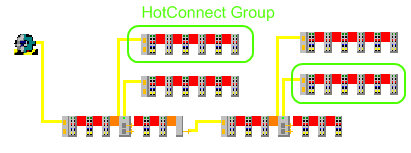
The following are suitable for use as branching points: EK110x, EK150x, EK1122, EP1122 and all slaves that have more than one IN and OUT port.
A Hot Connect group can be connected to any regular free port in the topology.
The combination of cable redundancy (chargeable supplement) in the main circuit and branching Hot Connect groups at radial connections is not permitted for the time being. The use of DC slaves is not yet possible when using cable redundancy.
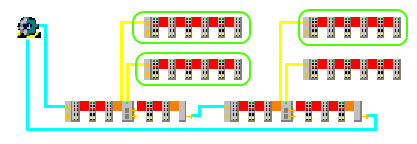
Type 2: Line
When using the line topology, all devices will be re-initialized when the connection is restored after a separation point.

If HC groups and non-HC groups are mixed in the line topology, all non-HC groups must be placed in front of the HC groups and (as is usual for EtherCAT) in the correct order.
In the picture here, a non-HC group is arranged in front of 3 HC groups. In an extreme case, all stations can be HC groups.
The use of cable redundancy (chargeable supplement) with HC groups in the redundancy path is not possible.
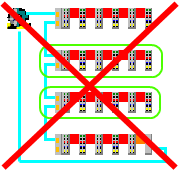
General notes
-
Stacked Groups
If Hot Connect groups are operated in physical succession (“stacked”), the higher level group must participate in traffic first before the lower level groups can be put into operation.
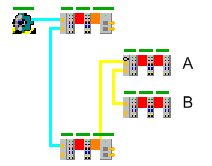
Sample: The groups A and B, each with their own address, are connected/switched on together. Group B (in spite of a possibly valid address) is only put into operation if it was possible for Group A to be put into operation regularly by the master.
-
Regular free ports
The Hot Connect groups can only be connected to free Ethernet ports in the configuration - if a group is connected to an irregular free port, the group is not put into operation, despite having a possibly valid address.
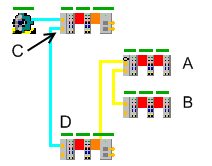
Sample: The coupler D (not a Hot Connect group!) is disconnected from Port C. Hence, port C is irregularly free. A Hot Connect group A or B connected to this port will not be put into operation by the master.